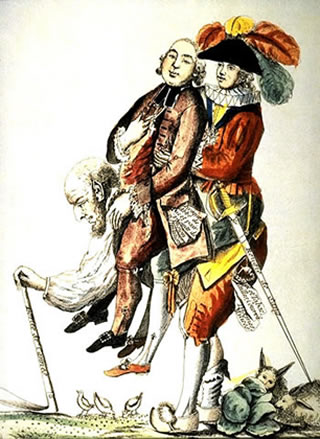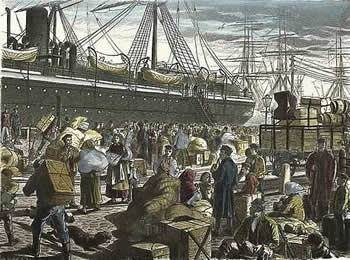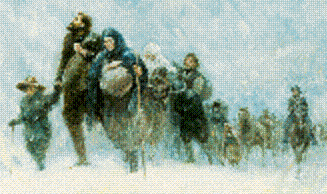You are in: Migration Museum > Migration Movements> South-West Germany in the 18th Century
Migration Movements1
(part 1 of 4)
Southwestern Germany in the 18th Century
 hen, in the 17th Century, southwestern Germany became a veritable land for immigration after the great depopulation during the Thirty Years War2 (1618-1648) and the War of the Palatine Succession3 (1688-1697), it had become an emigration area at the beginning of the 18th century.
hen, in the 17th Century, southwestern Germany became a veritable land for immigration after the great depopulation during the Thirty Years War2 (1618-1648) and the War of the Palatine Succession3 (1688-1697), it had become an emigration area at the beginning of the 18th century.

The Farmers, the 3rd Estate Bear the Burden
of the Other Two Estates.
However, division of real estate4, overpopulation, crop failure, excessive burdens of the state and religious oppression had at the end of the 17th Century led to emigration overseas. This included Protestants such as Mennonites5, Amish6 and Quakers7. Many of them came originally from the Palatine, where they had only a few years or decades of shelter. Little wonder that "Palatine", the English word for the Palatinate, was long considered a synonym for all immigrants from Germany.

emigrants
The first major mass migration to North America from the Palatinate of the 18th Century began in 1709. By 1727 approximately 15,000 "Palatines" had arrived at the port of Philadelphia. Between 1727 and 1775 they were followed by about 70,000 more people. In 1775 they made up a third of the population of Pennsylvania's German-born residents.
More about Germans in Pennsylvania ...... 

But the modern era of Europe is a history marked by religious conflict. The interplay of land powers of the State and the expulsion of dissident minorities led to emigration and immigration, migration, and last but not least of cultural mixing.
So it was in 1731/32 that about 20,000, who were displaced from the Archbishopric of Salzburg, found a new home in East Prussia.
Some of the settlements of the religious refugees were encouraged by the respective rulers by offering concessions because they hoped to thereby achieve an economic recovery.
If you want to see the spread of the German language in Europe in the different eras (7th to 20th century), click on the image
1 Thanks to S. Winkler for help with the English translation of this page
2 Thirty years war = Collective term for the European religion vs. State conflict which arose from the confessional contrast in the Holy Roman Empire of the German nation, and the contrast between the Habsburg monarchy and estates was fought on German soil from 1618 to 1648. Therefore, in the 17th and 18th centuries, one spoke also of the 'Teutsche' (German) war to characterize the area which suffered millions of deaths, devastation and barbarism. Recent history suggests it was a European war because in many of the countries power, religion and economic problems exploded violently. There were wars in the Netherlands, between Poland and Sweden, Sweden and Denmark, France and Spain.
Due to the economic and social devastation, some territories affected by the war required more than a century to recover from the consequences.
3 The Palatine war of succession was a French war of conquest in the Electoral Palatinate region and large parts of Southwest Germany. In 1685, after the death of Karl II elector of the Palatinate without leaving direct male successor, Luis XIV of France claimed it as his inheritance, as his brother Philippe I, Duke of Orléans, was married to the sister of the deceased.
4 Division of real estate = The possessions of a family, in particular the land, which was divided 'real' among the beneficiaries. This division took place at each inheritance, so that over time there were an increased the number of ‘mini’ plots. In agriculture the continued division of real estate led to a fragmentation of arable land in a variety of small fields, often in the form of narrow strips. In 'Old Württemberg' this division of real estate resulted in fields that were soon too small to feed a family and resulted, in part-time farmers in Württemberg who operated as craftsmen. At the same time the inherited estate secured a minimum maintenance, because you inherited not only a piece of land, but also a part of the parental home. However, there was often only single room where entire families crowded together.
5 Mennonites = Followers of an evangelical Free Church which practiced adult baptism and refusal of military service and the swearing of an oath.
6 Amish = A group of Amish Mennonites who, because of their stricter view of church discipline, separated from the rest of the Mennonites in 1693 and have since formed their own religious community.
7 Quakers = A Christian religious community, which became widespread, especially in the English-speaking parts of the world and in Africa. The basic belief is the concept of enlightenment through God that can reach every person as a source of knowledge of God and a truly Christian life. Sacraments, baptism and communion as children were discarded; pleasures were considered offensive; and military service was refused.
8 Exulant = A Protestant who was exiled from one of the countries of the Catholic Habsburg monarchy in the 17th and 18th centuries.



